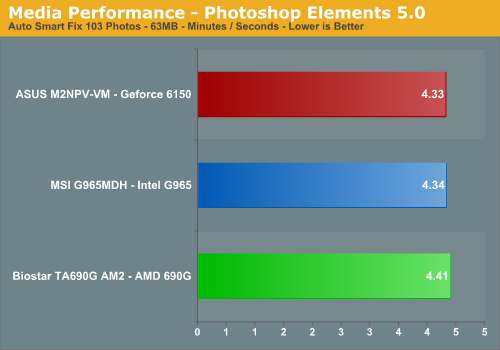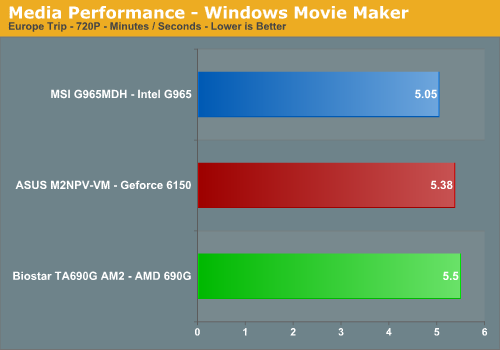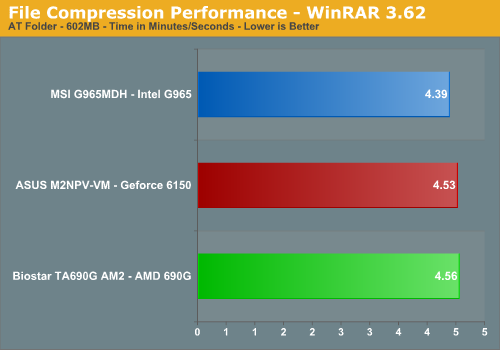Media Performance
We will take a brief look at general media performance with our test suite for that includes Adobe Photoshop CS3, Adobe Photoshop Elements 5.0, and Windows Movie Maker.
We utilize the widely available Retouch Artists Photoshop Speed Test for measuring platform performance in Adobe's Photoshop CS3. The benchmark applies a number of actions to a test image while we measure the total time elapsed during the active portion of the test. We set history states to 1, cache levels to 4, and CS3 was configured to make use of all available system memory. The scores reported include the full conversion process and is represented in minutes/seconds, with lower numbers providing better performance.

The results are once again interesting as we did not expect our AM2 systems to perform this well. Photoshop has favored the Intel Core 2 Duo greatly in the past and once again we are looking at a speed issue with the E6300 that allows the AM2 systems to be in the hunt.
Our next test is one recommended by Intel, but the test itself appears to be fair and results are very repeatable. This test simply measures the amount of time required to fix and optimize 103 different photos weighing in at 63MB. Time is measured in minutes and seconds, with lower times resulting in better performance:

This test not only stresses the CPU but also gives the storage systems a good workout. Our 6150 platform barely edges out the Intel platform in a test where sheer CPU speed can make up the difference in elegant design. That sounds so familiar, are we talking about the differences between Athlon 64 and P4 NetBurst or Intel Core 2 Duo and Athlon 64 X2? Either way you cut it, the 6150 once again finishes ahead of the 690G due to better storage system performance.
Next on the list is our Windows Movie Maker test that will meld our European vacation content (recorded off TV) into a newly downloadable file that can be viewed on our Xbox 360 in a pleasing 720p format. The values reported are in minutes/seconds for the conversion time, with lower numbers being better.

Our Intel platform has a significant advantage in this test with the 6150 scoring better than the 690G in a test that stresses both the CPU and storage system again. These results were interesting as previous testing with this application indicated our AM2 platform would be a little more competitive.
File Compression Performance
In order to save space on our hard drives and ensure we had another CPU crunching utility, we will be reporting our file compression results with the latest version of WinRAR that fully supports multi-treaded operations and should be of particular interest for those users with dual core or multi-processor systems. Our series of file compression tests utilizes WinRAR 3.62 to compress our test folder that contains 444 files, ten subfolders, and 602MB worth of data. All default settings are utilized in WinRAR along with our hard drive being defragmented before each test.

Our G965 platform basically zips away from our two AM2 platforms in this test that heavily stresses the CPU subsystem and at times the storage system. The Core 2 Duo has always excelled in this benchmark and once again shows its strength. We were surprised that our two AM2 platforms scored this well with the advantage going to the NVIDIA 6150 due to better storage system throughput in our opinion.
We will take a brief look at general media performance with our test suite for that includes Adobe Photoshop CS3, Adobe Photoshop Elements 5.0, and Windows Movie Maker.
We utilize the widely available Retouch Artists Photoshop Speed Test for measuring platform performance in Adobe's Photoshop CS3. The benchmark applies a number of actions to a test image while we measure the total time elapsed during the active portion of the test. We set history states to 1, cache levels to 4, and CS3 was configured to make use of all available system memory. The scores reported include the full conversion process and is represented in minutes/seconds, with lower numbers providing better performance.

The results are once again interesting as we did not expect our AM2 systems to perform this well. Photoshop has favored the Intel Core 2 Duo greatly in the past and once again we are looking at a speed issue with the E6300 that allows the AM2 systems to be in the hunt.
Our next test is one recommended by Intel, but the test itself appears to be fair and results are very repeatable. This test simply measures the amount of time required to fix and optimize 103 different photos weighing in at 63MB. Time is measured in minutes and seconds, with lower times resulting in better performance:

This test not only stresses the CPU but also gives the storage systems a good workout. Our 6150 platform barely edges out the Intel platform in a test where sheer CPU speed can make up the difference in elegant design. That sounds so familiar, are we talking about the differences between Athlon 64 and P4 NetBurst or Intel Core 2 Duo and Athlon 64 X2? Either way you cut it, the 6150 once again finishes ahead of the 690G due to better storage system performance.
Next on the list is our Windows Movie Maker test that will meld our European vacation content (recorded off TV) into a newly downloadable file that can be viewed on our Xbox 360 in a pleasing 720p format. The values reported are in minutes/seconds for the conversion time, with lower numbers being better.

Our Intel platform has a significant advantage in this test with the 6150 scoring better than the 690G in a test that stresses both the CPU and storage system again. These results were interesting as previous testing with this application indicated our AM2 platform would be a little more competitive.
File Compression Performance
In order to save space on our hard drives and ensure we had another CPU crunching utility, we will be reporting our file compression results with the latest version of WinRAR that fully supports multi-treaded operations and should be of particular interest for those users with dual core or multi-processor systems. Our series of file compression tests utilizes WinRAR 3.62 to compress our test folder that contains 444 files, ten subfolders, and 602MB worth of data. All default settings are utilized in WinRAR along with our hard drive being defragmented before each test.

Our G965 platform basically zips away from our two AM2 platforms in this test that heavily stresses the CPU subsystem and at times the storage system. The Core 2 Duo has always excelled in this benchmark and once again shows its strength. We were surprised that our two AM2 platforms scored this well with the advantage going to the NVIDIA 6150 due to better storage system throughput in our opinion.










70 Comments
View All Comments
SignalPST - Tuesday, March 6, 2007 - link
I'm interested in this topic as well.Then again, I still waiting for them to come out with a HDMI sound card.
StriderGT - Wednesday, March 7, 2007 - link
Unfortunately there are lots of us who are still waiting for a true HDMI PC audio solution. You can check the thread I started with many technical details for that matter here: http://www.avsforum.com/avs-vb/showthread.php?t=79...">http://www.avsforum.com/avs-vb/showthread.php?t=79...Patrese - Tuesday, March 6, 2007 - link
Great review, thanks... I know I asked that a couple times already, but is there a mATX roundup planned here at AT? I'd like to see the Asus M2NPV-VM and Abit NF-M2 NView compared with its 690G counterparts, as this segment makes for most of the computer sales on most places? BTW, weren't you plaged by memory compatibility issues with the M2NPV-VM oe any of the boards tested? This Asus board showed extremely picky on my experience...Gary Key - Wednesday, March 7, 2007 - link
The roundup is scheduled on the 19th, trying to pull it in. What BIOS and memory are you using on the M2NPV-VM, so far I have not run into any real issues except with 2GB modules. The abit board is one of my favorites so far. ;)Patrese - Tuesday, March 6, 2007 - link
There shouldn't be a question mark at the end of the "most sales" phrase... There are also a couple typos, sorry about that. Where's the edit button anyway? ;)RamarC - Tuesday, March 6, 2007 - link
i don't really understand the point of comparing chipsets/motherboards between processor families. subsystem performance figures can show glaring deficiencies but otherwise it really boils down to a cpu comparison. the "media/audio encoding" and "media performance" sections are certainly cpu-centric. and pitting a $230 x2 5200+ against a $185 e6300 winds up handicapping the intel contestant. shouldn't the $222 e6400 have been used instead?Gary Key - Tuesday, March 6, 2007 - link
As stated in the article, AMD is marketing the AM2 and 690G/V as a platform design to compete against the G/Q965 and Core 2 Duo solution. The 690G is targeted to the multimedia, HTPC, home/office, casual gaming crowd and was tested as such. We looked at the total price of a base Core 2 Duo and decent G965 board and then matched the processor choice that would come closest to the price and performance of the Intel offering while meeting the platform cost. Our tests were chosen based upon the target audience for each platform in the home environment. This was not a review of office level machines as the Q965/963 and 690V are targeted to the business user.JarredWalton - Tuesday, March 6, 2007 - link
The conclusion mentions that the G965 + E6300 costs around $300 compared to $315 for the 690G + 5200+ (or 6150 + 5200+), so it's more or less a fair "equivalent price" platform comparison. The E6400 ends up being faster than the E6300, but still slower in a few tests (as the text mentions) and even faster in those tests where E6300 already holds the lead. Nothing new there - we've pretty much beat the "Core 2 Duo is faster" drum to death. We feel anyone looking at 690G is going to be interested in the platform as a whole much more than whether or not it is faster than equivalently price Core 2 offerings.mostlyprudent - Tuesday, March 6, 2007 - link
There may be too many variables, but perhaps you could come up with a way to normalize the benchmarks. For instance, run the gaming tests first with ultra high-end graphics to try and isolate the performance delta for each plattofrm/cpu combo you will test with. Then run the game benchmarks with the IGP solutions and adjust the scores based on the previous tests. Just a thought off the top of my head.asliarun - Tuesday, March 6, 2007 - link
Ah, but you're evaluating a chipset here, not a platform or a system solution. Having said that, I agree that it IS difficult to compare chipsets that are targeted for different CPUs. In such a case, a better way to evaluate might be to take an AMD and an Intel CPU that is similar in performance (not in price), and use them to compare their corresponding chipsets. That would highlight the differences between the chipsets. You could always mention the price alongside, or do a separate price/performance comparison alongside.My point is that a price/performance comparison should complement a pure performance comparison, not the other way around.